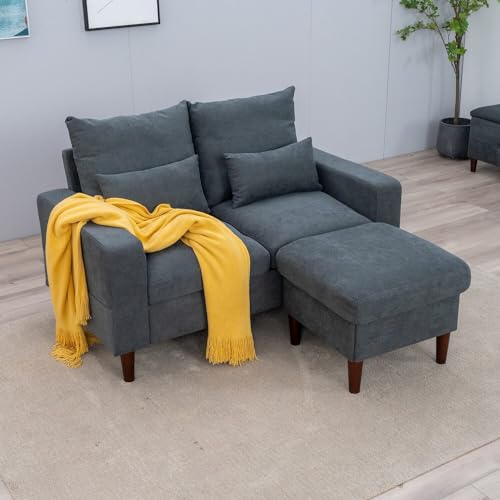Guide To 2 Seater Leather And Fabric Sofa: The Intermediate Guide Towa…
페이지 정보
작성자 Olivia 댓글 0건 조회 3회 작성일 24-11-16 10:23본문
 Choosing Between a 2 Seater Leather and Fabric Sofa
Choosing Between a 2 Seater Leather and Fabric SofaIt can be difficult to choose between leather and fabric when you are searching for a new sofa. This is especially true if you aren't a professional in furniture.
If you have kids or live in a smaller apartment, the leather option may be the best choice for you. It's easy to wipe down and it is stylish in all homes.
Comfort
A sofa is the main focal feature of many people's living areas and is a major purchase. You want a sofa that can be sat on for many hours and that looks good and will stand the test of time. It isn't easy to choose between fabric and leather however, you must take into consideration your lifestyle, budget, and other priorities before making a decision.
Leather is a high-end material that has a luxurious feel and radiates class in the home. It is strong, stain-resistant, resistant to pets as well as children, and will last for a long time when properly cared for. However, it can be more expensive in the beginning and could require regular conditioning to prevent peeling or cracking.
Fabric sofas are available in a vast variety of styles, colors and fabrics. They can be cheaper than leather ones. They are also more comfortable and more inviting, and can be "broken in" right from the beginning. They are more prone to dust mites and pet hairs, and require frequent cleaning. There are now hypoallergenic fabrics and new technologies that are available.
Fabric sofas can last for up to 15 years if they're properly maintained. Regular vacuuming and deep cleaning will keep the fabric 2 seater sofa free of odours, stains and dirt. Like leather, they are susceptible to flattening and sagging over time. In addition, a lot of fabrics are treated with chemicals to make them stain-resistant as well as flame-resistant. These can release volatile organic compounds that could alter indoor air quality and cause allergies.
Durability
When purchasing sofas, we often opt for fabrics that are extremely durable because this can be crucial if you have pets and children. You don't need to spend a lot of money in the beginning if you're going to regret it after the first scratch or claw. You don't want to buy something cheap 2 seater fabric sofa that can't withstand regular use.
Leather is also extremely resilient with a tremendous tear strength. It can last for up to four times longer than fabric and is innately resistant to fading, cracking and flaking. It can also be conditioned to replenish its natural oils, and look like new.
Fabrics are more affordable and come in many different designs, colors and textures that can be adapted to any style of interior. They are also easier to clean than leather and can withstand a decent amount of wear and tear, however, they can be more prone to moisture and be susceptible to fading as time passes.
Microfiber is tough and comes in a variety of colors. However, it may not be as durable as genuine leather. It may also not be able of enduring scratches. However, it's still an excellent choice for families because of its resistance to spills and stains, and it is easy to clean, usually with just a damp cloth.
Suede is more difficult to clean and repair than leather. It can lose its shape and feel rough if not regularly maintained. It's also a thin material and so might not be as sturdy as cowhide or sheepskin leather.
Allergens
Fabrics can have a significant effect on allergies. It's important to know the way different options work. Fabrics are prone to retaining allergens like dust mites and pet dander which can trigger symptoms such as hay fever, asthma, eczema, and rhinitis. This is because these fabrics act as an ideal environment for them to fester.
The leather, however, does not accumulate these allergens, and provides a consistent level of comfort, regardless of season. It can also trigger allergic dermatitis in those with contact dermatitis or are allergic to tanning chemicals. Using vegetable-tanned leather as well as maintaining an active skincare routine is crucial to reducing skin reactions.
Leather and fabric sofas are durable, but the material you choose will have a significant impact on how well your sofa can stand up to wear. A good quality fabric will stand up to the demands of daily usage without fading or sagging and can resist spills and body oils with ease. Modern sofas have stain-resistant treatments which make cleaning up effortless.
It's not possible to completely prevent an allergic reaction to the leather of your sofa but you can to avoid allergens by keeping an lint-roller in your home and regularly clean your living space. This will reduce the amount dust, pet hair, and dust mites you find on your sofa. If you are still experiencing issues with allergies, consider replacing your sofa for a more hypoallergenic model. For instance, a leather sofa 2 seater fabric made from vinyl or synthetic leather is less likely to collect dust mites and pet dander. It also can help you breathe more easily.
Scratches
When buying a leather sofa, it is important to consider how much wear and tear you can anticipate from it. The finish, colour and quality of the leather are all crucial aspects in the length of time a sofa will last. You must also ensure it's durable enough to withstand spills and other accidents. This can be accomplished by choosing a couch with a solid wood frame and high-density foam cushions.
Leather can be damaged by various reasons, including stretching it, marking territory or in the process of reliving tension. Scratches vary in severity. They can range from minor surface scratches, to deep punctures or cuts. Minor scratches can be treated by applying a conditioner for leather to the area affected. This can help restore the balance of moisture and oil in the leather, preventing it from drying out and cracking. The extent of damage will determine the treatment required.
If you have cats, it is recommended to trim their nails regularly as this can assist in stopping scratching on your couch. You can also retrain the scratching behavior by providing them with scratching surfaces such as sisal rope or cardboard. You can also use a pet-safe furniture polish which you can apply using an easy clean cloth.
In addition to cleaning your leather sofa regularly, it's a good idea to keep it out of direct sunlight and heat sources which can dry out the leather. This can cause it to crack and become difficult to repair and frequently requires reupholstery. It is recommended to apply a leather conditioner to keep the leather supple.
 Smell
SmellA leather couch tends to have a different scent than fabric. It's because leather is porous and can absorb odors such as smoke, body odors, or food. The good news is that odors tend to fade over time, particularly if you use a non-toxic, fragrance free cleaner.
If the smell is overwhelming It could mean that something is wrong with the foam. This is usually caused by the chemical off-gassing of polyurethane that is derived from petroleum. If you're worried about this, consider couches made with CertiPUR-US certified or natural latex foams.
A second way to identify faux leather is by feeling for bumps or a texture on the back of a sofa. This is a clear indication that it's bonded, not genuine top grain leather. You can also perform a visual check by laying the sofa over and observing any exposed upholstery backing. If you smell it, then it's likely a synthetic material like polyurethane or polyester. These types of materials will have a different scent than leather.
Cleaning your leather sofa regularly will keep it in good condition and smell great. This will keep it looking great and smelling great, as well as preventing it from becoming stiff or cracked as time passes. Start by vacuuming, dusting and wiping the couch with baking soda (a natural way to eliminate odors). You should do this at least once every two weeks or more to get rid of dust and dirt build up. Then, apply a leather conditioner to help preserve the color and texture.
댓글목록
등록된 댓글이 없습니다.